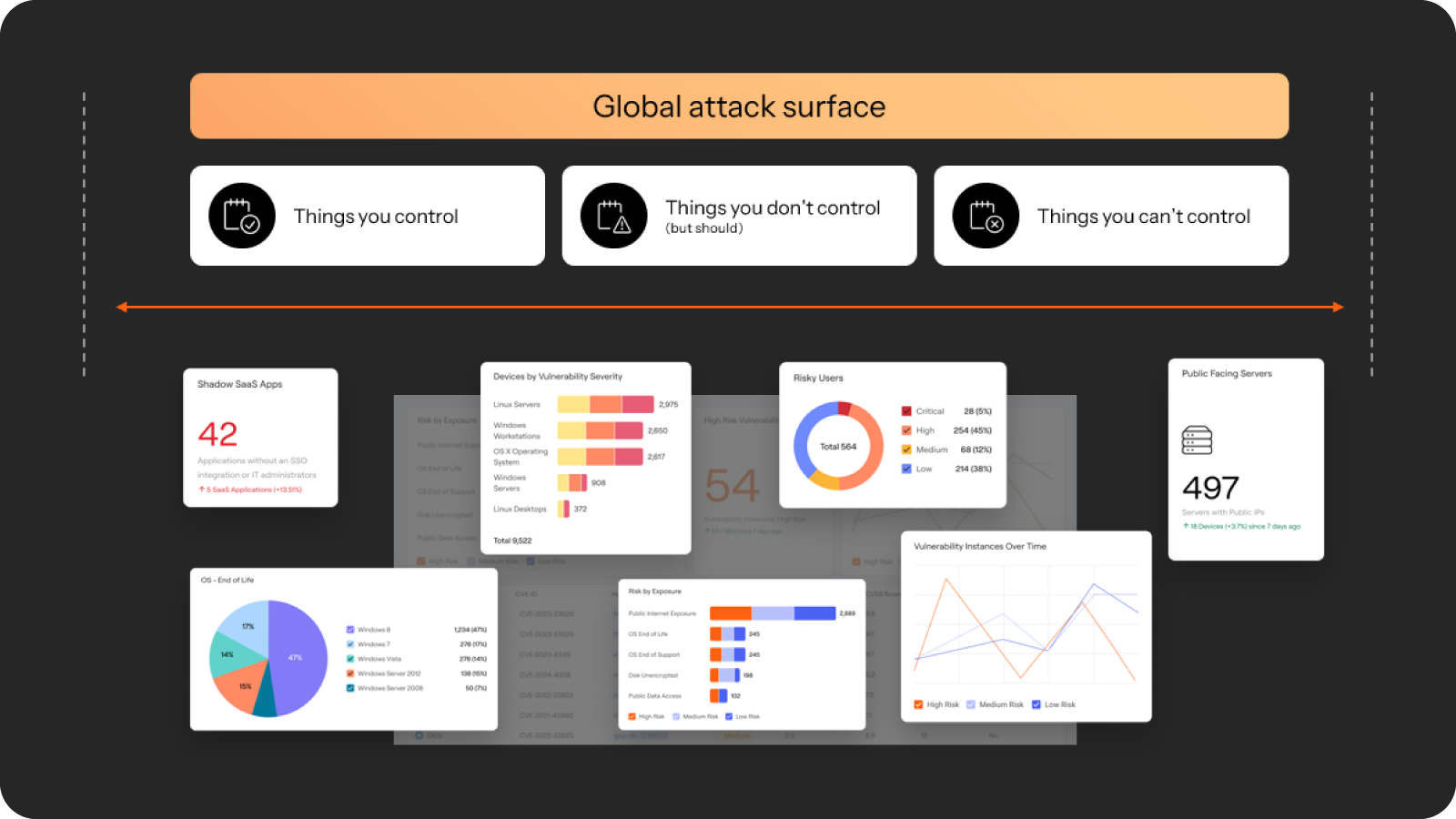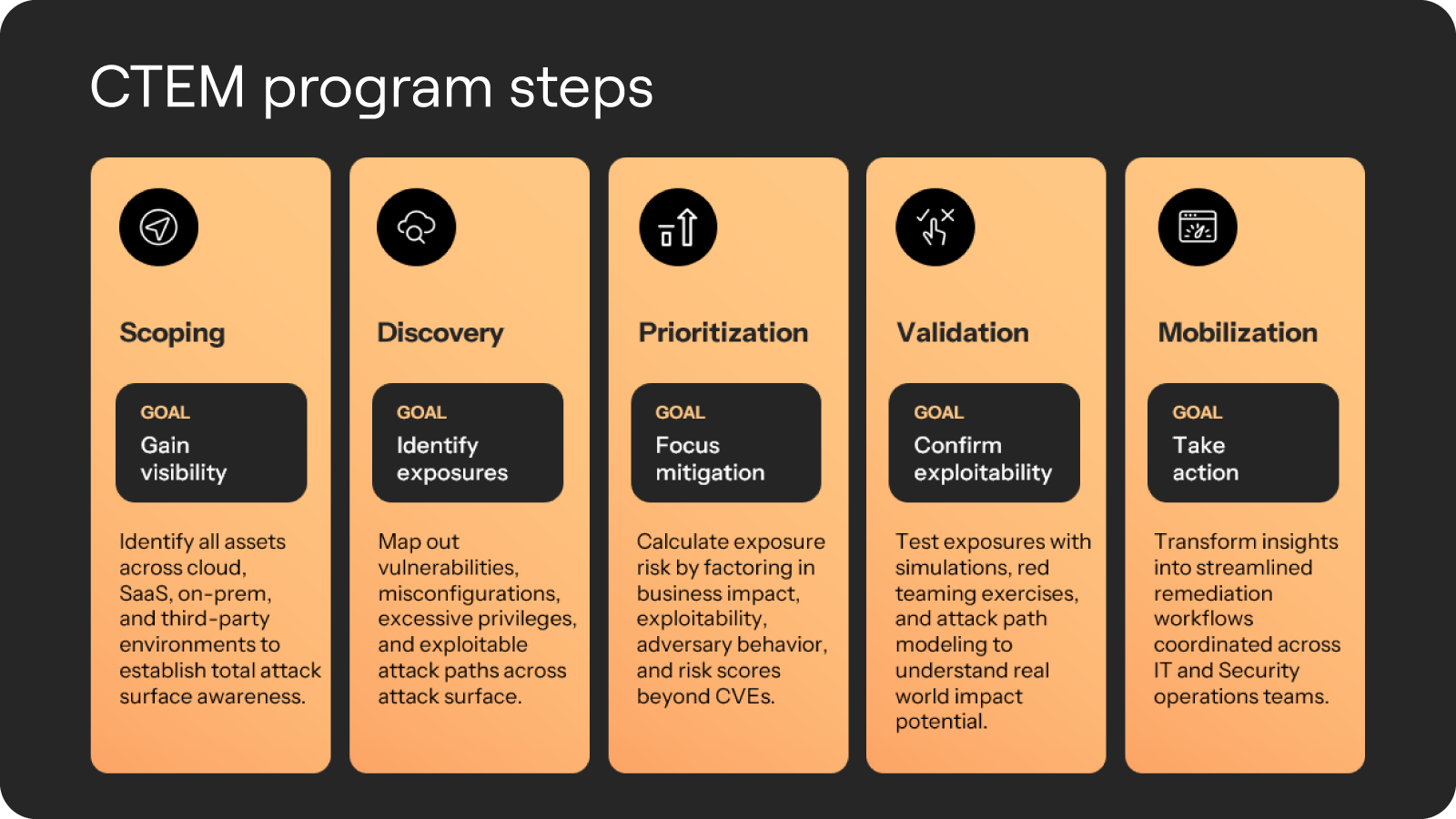CTEM in 30 days: 10 tips for a flying start
.jpg%3Fwidth%3D1720%26auto%3Davif%26format%3Djpg%26disable%3Dupscale%26quality%3D85&w=3840&q=85)
So, you've heard the buzz around CTEM, and you’re interested in running the framework. You want a strong launch and a program that compounds. But most CTEM programs stall before they start: not for lack of strategy, but because teams can’t prove impact fast enough.
If you want to launch within 30 days, we’re here to help. Below are 10 practical moves you should make to thoughtfully kick off CTEM. Each tip is designed to show progress that your leadership can feel, not just read in a report.
Want a deeper playbook? Grab our CTEM for Dummies guide for even more insights that’ll help your team get started today.
1. Scope small, win big
Pick one high-impact surface (a crown-jewel app or critical BU) and run your first loop there. Visible wins beat sprawling plans; prove value there, then expand.
Do now: Publish a 30-day goal (ex., “validated P1 exposures down X% in Payments”). Show the impact: Share a before/after chart showing validated P1s in that scope dropping from X → Y over 30 days. Note the % change. |
2. Get air cover early
Frame CTEM as a repeatable operating model for continuous risk reduction and smarter resource allocation, not a tool project. Set expectations and secure early air cover so ownership and SLAs don’t stall later.
Do now: Host a brief covering scope, success metrics, and cadence. Show the impact: Track and publish “decision latency” (the average days from exposure identified to action approved) and show the trend line moving week over week. |
3. Make your tools talk
When your systems share context, discovery gets sharper and prioritization isn’t just guesswork. No more spreadsheet archaeology. Just the right info in the right ticket.
Do now: Pipe scanner findings into Axonius, enrich with ownership/criticality/control posture, then push enriched tickets into Jira/ServiceNow via Enforcement Center. Show the impact: Publish the % of exposures reaching ITSM with full context (owner, business service, control posture) and compare pre- vs. post-integration. |
4. Focus on asset visibility first
You can’t fix what you can’t see. Use tools like Axonius to build a living inventory across endpoints, cloud workloads, SaaS apps, and identities. This is your foundation.

Do now: Use Axonius to connect your IdP, EDR, and CSPM adapters. Require Owner and Criticality fields via saved queries. Set a dashboard that flags assets missing those fields. Show the impact: Report the % of assets discovered and the % with owner + criticality each week, and highlight the lift since connecting Axonius adapters. |
5. Automate what you can
Let people do the work that needs judgment (like validating exploitability, weighing business impact, and approving exceptions) and let the machines handle the handoffs. Routing, owner alerts, ticket creation/updates, and safe actions should happen automatically.
Do now: In the Axonius Enforcement Center, create a rule: when a validated P1 hits a production asset, auto-create a P1 Jira/ServiceNow ticket, @notify the owner, set the SLA, and attach relevant evidence. Show the impact: Compare time-to-assign and time-to-fix before vs. after the rule. Report the % of tickets auto-created with full context and estimate minutes saved per ticket. |
6. Make ownership unmistakable
No more “Who owns this?” Define owners, ticket templates, SLAs, and what “done” means. Make ownership unmistakable and “done” verifiable.
Do now: Publish an ownership matrix by exposure type (team → ticket template → SLA → verification step). Store it where everyone lives (Confluence? Notion?) and link it in ticket templates. Show the impact: Share time-to-assign by team before vs. after the matrix, plus SLA adherence rates by team for the last sprint. |
7. Prioritize what matters, not what yells
A generic severity score from a scanner doesn’t just equal risk. Weigh asset context, business impact, compensating controls, exploitability, and threat intelligence to shift to risk-based prioritization, focusing on the exposures that pose the most significant and immediate threat.
.png)
Do now: Tag your scoped assets to business services, add compensating controls as fields, validate exploitability on the top exposure types, and re-rank the backlog by business risk. Show the impact: Share a top-10 list by business risk with one-line “why it moved” notes (ex., “Payroll API moved up: public-facing + token misconfig + active exploit”). |
8. Communicate clearly and often
Executives want risk deltas; operators want unblocked tickets. Release concise and regular updates: what changed, what moved, what shipped, what’s blocked.
Do now: Stand up the weekly CTEM huddle and one-pager update (email/Slack/Confluence). Show the impact: Count blockers cleared per week and include one concrete example (“Ticket #123 moved after SRE added maint window”). |
9. Measure what matters
Consistently tracking a few cybersecurity metrics that matter beats pretty dashboards nobody reads: time-to-validate, time-to-fix, % validated→fixed, re-open rate (add aged validated exposures >30 days and coverage completeness if helpful).
Do now: Standardize these KPIs and publish trend lines weekly. Show the impact: Annotate your charts with the changes you made (new rule, new owner, new SLA) so the lines tell a cause-and-effect story. |
10. Spotlight the wins
When a real risk drops or a workflow gets faster, share the story. Momentum is contagious, and it buys you runway to scale.
Do now: Add a “Win of the Week” tile to your weekly CTEM update. Show the impact: Post the win with a one-line outcome (ex., “Payments API: 46% drop in validated P1s in 3 weeks”) and track participation (submissions/week) to show engagement. |
CTEM isn’t about boiling the ocean. It’s about momentum. Nail month one, and you’ll earn the right to scale.
Get the guide: CTEM for Dummies (Axonius Special Edition)
CTEM works when it’s continuous and visible. Start small, wire the hand-offs, measure the right things, and let momentum do the rest. If you can show impact in 30 days, you’ll earn the air cover to scale across more apps, more teams, and more of the attack surface.
These 10 tips are your starter kit. For the full playbook, including deeper guidance, frameworks, do’s and don’ts, and more, get CTEM for Dummies.

Categories
- Threats & Vulnerabilities

Get Started
Discover what’s achievable with a product demo, or talk to an Axonius representative.

